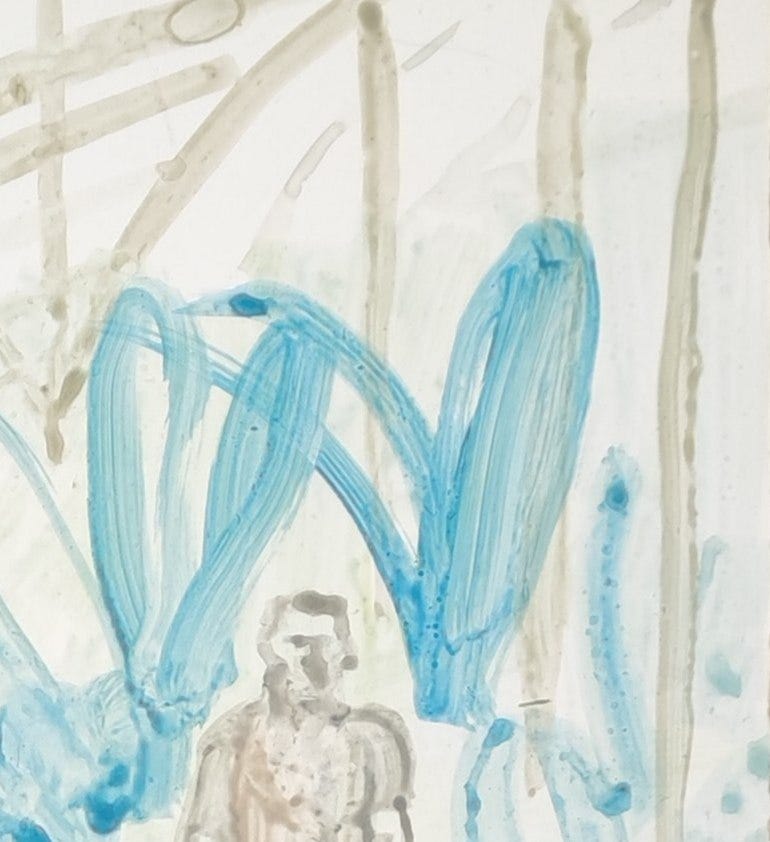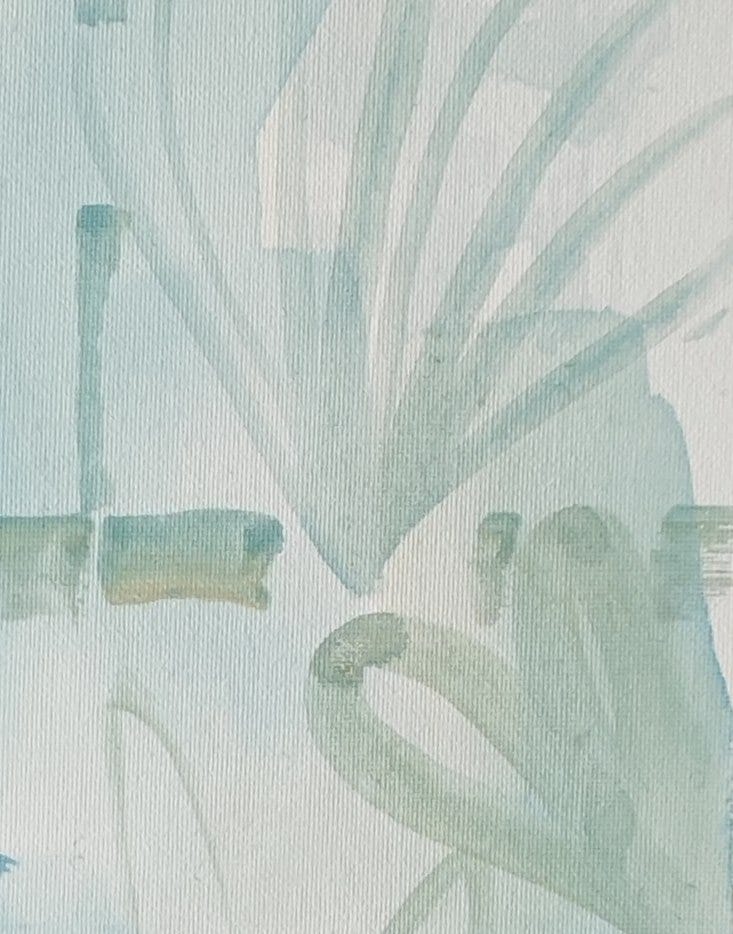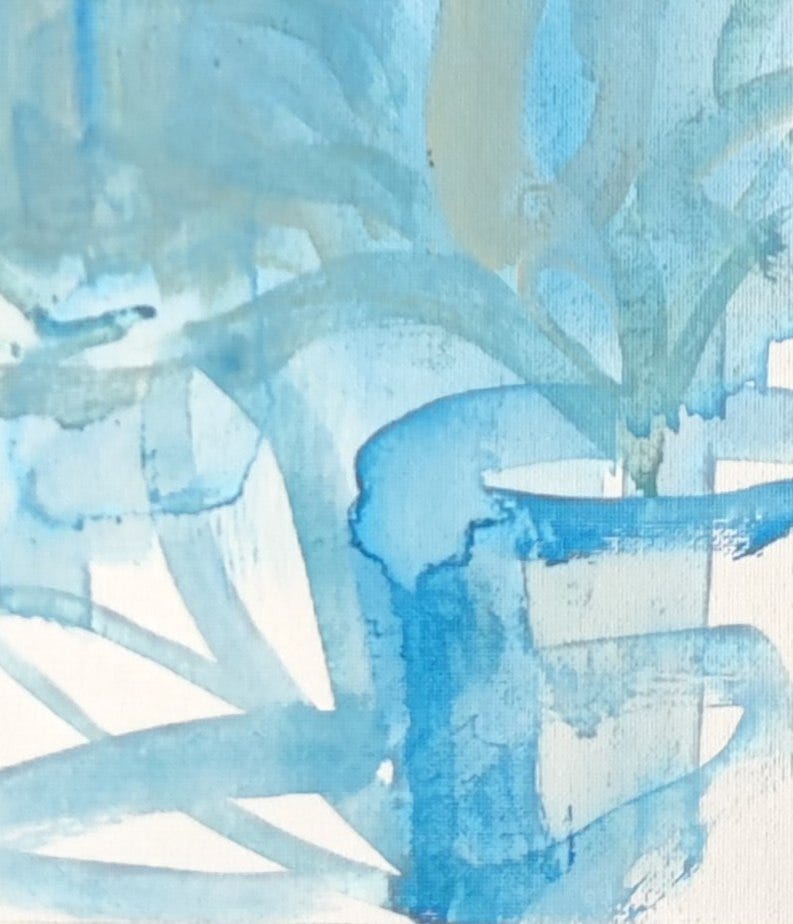Canvas Panel Letter:
On canvas, on managing transitions and on working your unique artistic territory.
I
Art Process: On Canvas (or similar)
In the last few years I’ve worked mostly on paper, whether it be in sketchbooks or on artist-grade paper originals.
I have dipped my toe into working on canvas of various sorts before but only to a small extent but in this period I have been investigating the canvas-based possibilities out there a bit more seriously as I am contemplating a shift into making work on canvas a major part of my future art practice.
And so far it has been tricky to say the least. Let’s say I have found temporary solutions, or partial solutions. I was attracted to working on wooden boards and gesso boards and tried out a few and didn’t like the surface and found it tricky to work with even when pre-gessoed. I just don’t feel it is for me although I won’t say that I mightn’t change my mind in the future as I gave it up quite quickly (because it seemed to very much not agree with the way I like to work).
I don’t love stretched canvases either thus far and have yet to try aluminium panels (although I feel I most likely would react against their absolute hardness and sheerness as I did with the wooden boards). And so, for now, my surface of choice, is a canvas panel. It is, for me, the right firmness, the right texture and I like the lightness and portability of them. The only thing that possibly worries me a little is whether they are built to survive into the future, although I am using a good Italian brand, Belle Arti.
One other possibility I might consider in the future is a deep mounted canvas as I do like the way they are ready to hang, unframed in many instances, as they are. But my research hasn’t extended that far yet. I am still grappling with the strangeness of painting with a new, strange paint (acrylic) on a new, strange surface. I have enough newness in this formulation to occupy all my problem-solving faculties for several months to come!
II
Process Notes: On managing transitions
I have been changing and shifting and fluctuating in my art practice over the last few years almost month by month. And that isn’t because I am virtuously adventurous and hopefully it isn’t because I am too impatient or lack discipline.
Instead, I would argue that I am doing it to a purpose as I have wanted to expand what I do and what I can do by “trying out” unexplored areas that interest me or areas that I believe may constitute the logical “next step” in my art practice.
And so, for instance, this has involved wanting to assimilate paint into my mixed media work which eventually involved assimilating watercolour, gouache (and now lately, acrylic) into my repertoire of media. And then that involving seeing what could be achieved with paint alone first on paper and now on various types of canvas or board.
And honestly, intrinsically I am the absolute opposite of adventurous regarding new things, new methodologies, etc. Left to myself I would happily stay in a niche and work it endlessly. In fact, my most recent niche, an unexpected one, watercolour on paper, surprised me as it felt very natural and comfortable, and I would have been delighted to stay there for much longer, possibly forever!
But no, I have transitioned recently to acrylic and I will admit it is still uncomfortable for me. For instance, it feels less immediate, less easy in terms of mixing as you have to fiddle with tubes and managing a palette is different and additionally I can’t use some of my favourite brushes. Or I will have to find or buy new favourites - and sourcing the perfect brush for a new medium is some task!
So this hasn’t been a seamless transition whereas when I shifted size or texture of paper in the past it felt like an adjustment but there were enough familiar elements involved to carry me through.
But as I am in the front-line of a current art-based “struggle”, I thought I would share some observations on managing the transitions, large and small, that are part of any developing art practise.
Firstly, I would say don’t judge your progress on the quality of finished pieces. You are in a transitional phase and so you are finding yourself, your methods, your flow (all of that!). Everything you produce in this phases constitutes an experiment still as there are so many unknowns. So each work is only a trial piece.
Secondly, allow yourself time and space to find the materials you need to succeed. When you are comfortable in a particular medium it is because you have found a process that works for you, the brush or brushes that work for you, the right surfaces, the right palette. All of that. And those discoveries are as important as any work you might produce at this stage.
And, finally, allow yourself to produce the inevitably imperfect work as you will be so hyper-aware of your errors and frustrations that you will have the right mindset to find solutions. This is a thinking and testing phase. And I will add this observation: just as I think sketchbooks and studies are often as valuable and as interesting as many pieces we might deem the actual “serious” or “finished” work, transitional phase pieces can often be very useful, unique and singular. In a transitional phase your style hasn’t hardened into habit, for good or ill. Sometimes established art styles atrophy over time as certain lessons may have been learnt and perfected but nothing new has been added in the meantime. Everything during a transition phase, raw and crude though it may appear to be, drips and sweats various shades of newness, and that is worth a little discomfort.
III
Art Adjacent: On the small field of interest each artist occupies
I suppose one of our tasks as artists is to claim our artistic territory or territories, whatever it or they might be. And that, for the most part, will tend to constitute a fairly small field of interest.
I’ve talked before series and sequences and returning to subjects in my work. The simple fact is that I try to keep faith these days with my own personal references which is a small pool of photos and memories. In my sketchbooks I have allowed myself to use other (copyright free) reference photos and I sometimes use vintage photos with the understanding that copyright on them will have expired, but generally my work reflects and follows the limits of my life.
And that’s fine. Do I wish I had limitless access to any reference image I could imagine? Perhaps sometimes, but actually not most of the time. Because I feel our other task as artists after we have claimed our territory is to commit to fully exploring it to the best of our abilities and I am fine with the discipline of that as I feel there is a sort of limitlessness between the lines too.
We all live one life and have one perspective, and although both may be subject to great change, we do have limits to our experiences that are themselves a discipline and a creative challenge (just in case you were looking for either of those things in your work!)
I have made peace with that (almost) completely. After all, I am not an illustrator so I don’t need to be a generalist (and even illustrators will have certain limits and preferences). And there is a strength (and the sense of a singular vision) to anyone who projects their specific, unique field of interest and experience into their work.
V
Originals
I will be periodically showcasing small amounts of originals (five maximum) on Big Cartel, accessible via my bio in instagram (as part of my linktree) & here: Shop.
And if you are interested in pictures not currently listed I can add them to the store.
VI
A reminder: if you have enjoyed any aspect of my monthly posts do consider liking, and subscribing to this newsletter. It would really mean a lot and help me maintain this space going forward
Finally if you like my artwork and want to support its continuance you might also consider a small paid subscription. It would be much appreciated so I can evolve and develop my practice. Many thanks.








So much of your experience is familiar to me and what you say here resonates. "...but generally my work reflects and follows the limits of my life."
I've been painting with acrylics for three years religiously and still have not found the perfect brush. Let me know if you do.